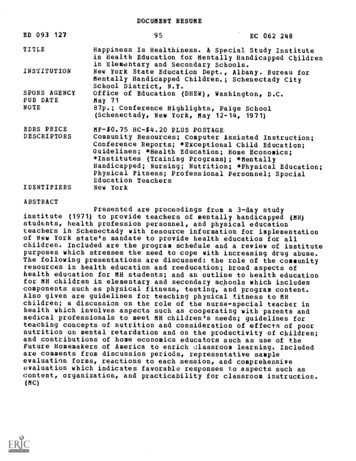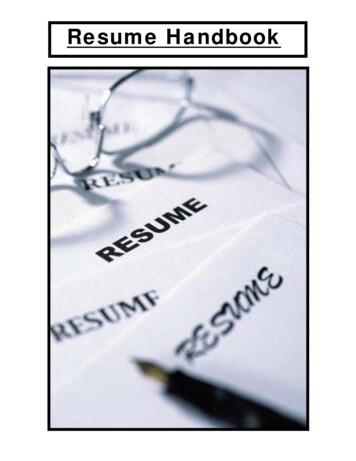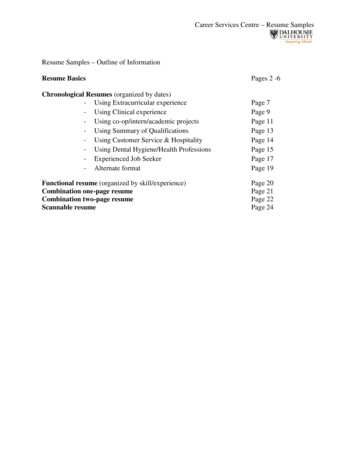
Transcription
DOCUMENT RESUMEED 093 127TITLEINSTITUTIONSPONS AGENCYPUB DATENOTEEDRS PRICEDESCRIPTORSIDENTIFIERS95EC 062 248Happiness Is Healthiness. A Special Study Institutein Health Education for Mentally Handicapped Childrenin Elementary and Secondary Schools.New York State Education Dept., Albany. Bureau forMentally Handicapped Children.; Schenectady CitySchool District, N.Y.Office of Education (DREW), Washington, D.C.May 7187p.; Conference Highlights, Paige School(Schenectady, New York, May 12-14, 1971)MF- 0.75 HC- 4.20 PLUS POSTAGE,Community Resources; Computer Assisted Instruction;Conference Reports; *Exceptional Child Education;Guidelines; *Health Education; Home Economics;*Institutes (Training Programs); *MentallyHandicapped; Nursing; Nutrition; *Physical Education;Physical Fitness; Professional Personnel; SpecialEducation TeachersNew YorkABSTRACTPresented are proceedings from a 3-day studyinstitute (1971) to provide teachers of mentally handicapped (MH)students, health profession personnel, and physical educationteachers in Schenectady with resource information for implementationof New York state's mandate to provide health education for allchildren. Included are the program schedule and a review of institutepurposes which stresses the need to cope with increasing drug abuse.The following presentations are discussed: the role of the communityresources in health education and reeducation; broad aspects ofhealth education for MH students; and an outline to health educationfor MH children in elementary and secondary sc)ools which includescomponents such as physical fitness, testing, and program content.Also given are guidelines for teaching physical fitness to MHchildren; a discussion on the role of the nurse-special teacher inhealth which involves aspects such as cooperating with parents andmedical professionals to meet MH children's needs; guidelines forteaching concepts of nutrition and consideration of effects of poornutrition on mental retardation and on the productivity of children;and contributions of home economics educators such as use of theFuture Homemakers of America to enrich classroom learning. Includedare comments from discussion periods, representative sampleevaluation forms, reactions to each session, and comprehensiveevaluation which indicates favorable responses to aspects such ascontent, organization, and practicability for classroom instruction.(MC)
3h266 16LIINIM66"The University of the State of New YorkTHE STATE EDUCATION DE'ARTMENTBUREAU FOR MENTALLY HANDICAPPEDU5 OEPARTMENTOF HEALTH.EDUCATION 8.'1NELFARENATIONAL [NSTiTUTE OFEDUCATIONff7',F,/ A.,2'F."ffa'cw2, % %E%.7,F%f.E PRO.,, FEl F i.EDw:.*fEff Roy!DO. COP,41,j,45Fin cooperation withBEST COPY AVAILABLEEFef;7%THE CITY SCHOOL DISTRICT OFTHE CITY OF SCHENECTADYPresent Conference HighlightsA Special Study Institute inHealth Education for MentallyHandicapped Children in Elementaryand Secondary SchoolsMay 12,13,14,1971Paige SchoolSchenectady, New YorkSpecial Studies InstituteFunded through P.L.91 - 230, as amendedU.S. Office of Education
PLANNING COMMITTEENew York State Education DepartmentDivision for Handicapped ChildrenRaphael F. Simches, Assistant DirectorRonald Ross, Chief, Bureau for Mentally Handicapped ChildrenSalvatore Tavormina, Associate, Bureau for MentallyHandicapped ChildrenCity School District of the City of SchenectadyBruce Brummitt, Superintendent of SchoolsJayne B, Rycheck, Director of Special Education
INSTITUTE STAFFJayne B.Rycheck, Institute DirectorDirector of Special EducationSchenectady City SchoolsFrancis E. Willette, Chairman for Local ArrangementsExhibits, Publicity, Coordination Activities andAssistant to Director of Institute, Special ResourceTeacher, Assistant in Department Special EducationSchenectady City SchoolsJohn S. Sinacore, Chief, Bureau of School Health Education andAssistant to the Commissioner on Drug EducationJohn J. Grant, Director of Health and PhysicalSchenectady City SchoolsEducationGeraldine Burr, CoordinatorNurse-Teachers, Schenectady City SchoolsShirley M. Ebetino, Director of Instructional ResourcesMaterials Center, Schenectady City SchoolsMarjorie Sherman, Supervisor, Home EconomicsSchenectady City SchoolsHelen Nichols, School LibrarianSchenectady City SchoolsRobert Dolins, CommissionerNew York State Narcotics DivisionGary Shaver, Director of EducationNew York State Department Social ServicesLaura Evans, Supervisor, Bureau of Home EconomicsNew York State Education Department
TRAINEES OF SPECIAL STUDY INST1lUfEAlbert R. Alexander, Jr.10 Cherry LaneElnora, New York 12065Yvonne DurlandHamilton SchoolSchenectady, New YorkSister Eileen BarrySt. Joseph's Provincial HouseValatie, New YorkMorton L. Goldberg40 Colonial AvenueAlbany, New York 12203Constance S. BenhamSt. Regis FallsNew York 12980Helen Louise Halloran1226 Union StreetSchenectady, New YorkJohn ArmstrongIron Gate ApartmentSouth BroadwaySaratoga, New YorkSister Lucina Hayes432 Western AvenueAlbany, New York 12203Stanley Harris3297 Marie StreetSchenectady, New YorkRosalie BradtWaters Road R.D. #3Amsterdam, New York12304Helen M. R. HoganLincoln SchoolRobinson StreetSchenectady, New YorkGeraldine Burr1830 Lenox RoadSchenectady, New YorkAnn Marie Brown80 Elm StreetMalone, New York22 Hutchins Road, R.D. #6Ballston Spa, New York 120201230812953Robert HughesBOCES Educational Center420 Last German StreetHerkimer, New York 13350Sister Domino M. JoachimSt. Coleman'sWatervliet, New YorkJo Ann T. BurnsCase Junior High SchoolWatertown, New YorkDonald Joyce480 West StreetAlbany, New YorkDiane Cornell1Andrews Road, Apt. 6Troy, New York 12180Mrs. Mary June Kavanagh10 Colonial PlaceCornwall-on-HudsonNew YorkEleanor Carren19() South Buckhout StreetIrvington, New York 10533Philip Cook456 North Main StreetLiberty, New YorkSister M. JoachimSt. Coleman'sWatervliet, New York12206Sist,:q- Marie Charles Norton91 Overlook AvenueLatham, New York 12110Judith N. Kiernan1068 VanAntwerp RoadSchenectady, New York12309Eleanor LoomisBurnt Hills, New York12027viiVllr
Trainees InstituteJohn B. Miller360 State StreetHudson, New York(Continued)Lois SoferSpecial EducationTMR - ElementaryYates SchoolSchenectady, New York12534Dorothy Mahar1102 Menwood BoulevardSchenectady, New YorkMildred M. Maras2100 PlazaSchenectady, New YorkLeonard ZulloSpecial Education - EMRHigh SchoolLinton High SchoolSchenectady, New York12309Marjorie M. NorcrossNortheastern Clinton Central SchoolMooers, New York 12958Betty M. Filarski1073 Lexington AvenueSchenectady, New YorkMarlene HessionSpecial Education - TMRBrandywine SchoolSchenectady, New YorkElementaryCatherine MurphySpecial Education - ElementaryPleasant Valley SchoolSchenectady, New York12309Helen O'BrienBox 48Saratoga Springs, New York12866Mrs. Chris Selling106 Bloomingrove DriveRensselaer, New YorkBenjamin Shavitz44 Ellish ParkwaySpring Valley, New YorkSeniorMaryanne MikolaitisSpecial EducationEMRLincoln SchoolSchenectady, New YorkElementaryEileen DanielsSpecial Education - ED - ElementaryKing SchoolSchenectady, New York10977Sister Marie CharlesSchool for DisabledNorth Colonie School DistrictNewtonville, New YorkGertrude BilewiczSpecial Education PerceptuallyHandicappedProject AbleHorace Mann SchoolSchenectady, New YorkSister Mary ChristineSpecial Education DepartmentSt. Rose CollegeAlbany, New YorkCharles MurraySpecial Class TeacherSaratoga BOCESJoan RobinsonSpecial Education Materials CenterAlbany, New YorkSister MonicaGuest from St. Rose CollegeAlbany, New YorkMargaret GarnerSpecial Education News ImpairedBrandywine SchoolSchenectady, New YorkMarjorie ShermanSupervisor in Home EconomicsSchenectady, New YorkMargaret Marzowski, Nurse-TeacherPaige and Pleasant Valley SchoolsSchenectady, New York
FOREWORDThis publication summarizes the Proceedings of the Special StudyInstitute held at Paige School, Schenectady - May 12-14, 1971, underthe sponsorship of the Division for Handicapped Children, Bureau forMentally Handicapped Children, New York State Education Department, andthe Schenectady City School District.The Institute was funded throughP.L. 85-926, as amended, United States Office of Education.The purpose of this Institute was to bring together special classteachers of the mentally handicapped, school-nurse teachers, healthpersonnel, selected supervisors and representatives from pupil-personnelservices and physical education staff who work with mentally handicappedchildren, for the purpose of providing them with resource and backgroundinformation to help implement the State's mandate for health education toall children.To fulfill this purpose, selected consultants from various collegesand universities and State Department Units presented and reviewed theknowledge and materials available in the field of health education whichcould be useful with the mentally handicapped.The content representedin these proceedings includes much of the discussions and some of theresource materials that were made available to the participants.The participants representing city, and selected Board of CooperativeEducational Services personnel were most interested and evaluated mostsessions accordingly.The composite evaluation is included in this report.This publication should serve as a further stimulus and motivator,to all who participated and those who read it to use the contents forresourceful application of health education for mentally handicapped children.Xil
ACKNOWLEDGMENTThe contents of this proceedings represent the efforts of all personsnamed in its pages,Special acknowledgments go to (1) Mr. Salvatore Tavormina, who helpedwith the necessary finding and advising in the planning of the instituteand in the preparation of the proceedings, (2) to Dr. Ronald Ross for hisadvice, (3) to Dr. Bruce Brummitt for making it possible for wide staffparticipation and making available excellent facilities for this studyinstitute, (4) to Mr. Francis Willette for assisting with local coordination, (5) to Miss Sue Gallo, Principal at Paige School and her staff,and (6) to the Schenectady City School District and New York State Department members of the planning committee.Gratitude is also tendered to the institute speakers and consultantswho made available their speeches and presentations for purposes ofpublishing this report.Finally, appreciation is extended to Dr. Anthony J. Pelone andMr. Raphael F, Simches of the Division for Handicapped Children, NewYork State Education Department.Jayne B. RycheckInstitute DirectorSchenectady City School Districtxiii//XIV
CONTENTSPlanning ConmdtteeiiiInstitute ogram SchedulexiiixvxviiGreetings and Opening Remarks1Overview - Purpose of the Institute2Summaries and Outlines of Presentations5Comments from Discussions andQuestion and Answer Periods62Evaluation Forms64Summaries of Evaluations68
Program ScheduleWednesday, May 12, 1971Paige School, Elliott Avenue at Consaul Road, Schenectady, New York1:00-1:30 p.m,1:30 - 4:30 p,m,RegistrationGeneral Opening SessionAuditoriumTheme - Happiness is HealthinessGreetingsDr, Bruce Brummitt - Superintendent of Schools City School Districtof the City of Schenectady, New YorkOverviewMr, Salvatore Tavormina, Associate in Bureau for Mentally Handicapped,Division for Handicapped ChildrenNew York State Education DepartmentHealth Education CurriculumSociological and Environmental AspectsDr, Gordon Bianchi, Coordinator Health Education ProjectInstitute Materials CenterState University College at Buffalo, New YorkMiss Sarah Dunne, Special Project Coordinator-Unit on Drugs and HealthEducationMr, Thomas Claybock, Institute Materials CenterState University at BuffaloSuccessful ExperimentationPersonal and Physical HealthMrs, Joanne Scullie, Supervisor Division of Health and PhysicalEducation, State Education Department
Program Schedule-cont.- page 2Special Educators from Schenectady City School DistrictSpecial Education DepartmentMrs. Rosalie Bradt, Lincoln School-EMR - PrimaryMiss Judith Kiernan, Steinmetz School-Miss Helen Halloran, Linton High SchoolEMR - Junior High School-EMR - Senior High SchoolMrs. Eleanor Loomis, Mont Pleasant High SchoolMrs. Elizabeth Pilarski, Brandywine School--EMR -Senior High SchoolEMR - Younger ChildrenMrs. Yvonne Durland, Hamilton School - TMR - Older ChildrenMr. Gordon Jenkins, Grout Park School - U/H 4:30-6:306:30 - 9:30ElementaryDinnerOpen Evening Session to include MohawkCouncil for Exceptional ChildrenCommunity Resources in Health Education and ReeducationExhibits and Materials DisplayMrs. Karen White, Senior Recreation Therapist, Wilton State SchoolMr. Oscar E. Carter, Director of Education, Tryon School for Boys,Johnstown, New YorkMr, Walter Silver, Associate Narcotic Education, Narcotic AddictionControl CommissionThursday, May 13, 19718:30-9:01)9:00 - 11:30RegistrationGeneral SessionBrf,ad Aspects of Health Education for the Mentally RetardedDr. Harold J. Childs, Chairman Physical Education Department,Springfield CollegeSpringfield, MassachusettsixxX
Program Schedule11:301:30--cent.-page 31:30Lunch4:30Health in Relation to Physical Fitness, Rest,Exercise, and RecreationMr. John Newman, Associate Professor, Physical EducationSpringfield CollegeSpringfield, MassachusettsFriday, May 14, 19718:30-9:00Registration9:00-11:30The Nurse-Teacher in Health EducationMrs. Dorothy B. Miller - Role of Nurse-Teacher in Health EducationConsultant, Division of NursingState University College at Plattsburgh, New YorkImplementation of Health Strands in Special EducationMrs. Frances Deming, Associate in Nurse EducationBureau of Health ServicesNew York State Department11:30-1:30Lunch1:30-4:00Health in Relation to NutritionMrs. Marie McGrath, Division of Home EconomicsState University College at Plattsburgh, New YorkContribution of Home Economics to Health EducationMrs. Doris Belton, Associate in Bureau of Home EconomicsDivision of Occupational EducationNew York State Education Department4:00-4:30Closingxxi
BEST COPY AVAILABLEGREETINGS AND Oi'.:NING ?EXARKSDr. BruCe Brummitt, Superintendent of Schools, City School District of theCity of Schenectady, New YorkWe are privileged to have you with us this afternocin.for the conference offers some truly unusual opportunities.is most appropriate.The progrtu;i'Your themeWe might turn it around to say that, "healthinessis Happiness;" that is, if Snoopy doesn't mind.Handicapped young peoplehave the same concerns about growing up and being healhy as their morefortunate brothers and sisters.I urge you to do all within your power to become.,:e knowledgeableand effective in providing the best in health education for our specialchildren.Perhaps their need is really greater.A good healtn education and personal hygiene program could give themone up on other youth and a more equal chance for thu good life.
PURPOSE OF IN 1 17.11,a&Salvatore A. TavorminaOn behalf of the Division for Handicapped Children of the StateEducation Department, I welcome you to this Special Study Institute.Weappreciate the cooperation you have given thus far by attending theInstitute.Your respective superintendents have expressed their confidencein this type of professional development by endorsing your participation.The planning committee has attempted to develop a format which will makethe next three days worthwhile for all of us.This conference is about health education.Starting in September 1971,all schools in New York State were mandated to offer a program in conformitywith the regulations of the Commissioner.These regulations provided thatthe elementary and secondary school curriculum include health educationfor all pupils.This applied to mentally handicapped children in elementaryand secondary programs.Such health teaching must largely be done by guiding the children indeveloping desirable health behavior, attitudes and knowledge throughtheir everyday experiences in a healthful environment.This guidancemust include systematic practices of health habits as needed.In additionto continued health guides, provision must be made for planned units ofteaching which include health instruction through which mentally handicappedpupils become increasingly self-reliant in solving their own health problemsand those of the group.Health education in the elementary and secondaryschools must be carried on by the special education teachers with the supportof school nurse teachers, health education personneland physicians.The educational requirements must be concerned about cigarette smoking,drugs and narcotics, and excessive use of alcohol;as well as all other
aspects of health which include nutritition and hygiene.For example, there is presently considerable concern about thealarming increase of youthful drug abusers in New York State.At thelast session of the legislature, 45 million was appropriated to combatthe increasing drug abuse problem.Although the appropriation was aimedprincipally at treatment and rehabilitation, the Education Department wasmandated also to develop a full health and drug education program which wasto be coordinated with an overall community effort.As set forth in the Governor's Model Community Program for YouthfulDrug Abuse, the school was to be s:Lgnificantly involved as part of thecommunity effort with the following responsibilities to be assumed in theschools;Education Teachers should learn basicknowledge in the area of drugs in order to includeit in their teaching and to help counsel studentsand refer them to medical help when needed.1.All Specie.2.Health Education Coordinator to coordinate Healthand Drug Education, health services and counselingefforts, and to serve as a liaison with communityprograms.3.Health Education Teacher to provide in depth druginstruction to students at the secondary level.4.Counselors and u:hool psychologists to provide primarycounseling for students who are experimenting with orabusing drugs.5.School physicians and nurses to conauet physicalexaminations (including urinalysis) that willreveal drug use, serve as counselors to studentsand to make referrals to community rehabilitationfacilities as needed.Thirty-five participants have been invited,Included in this numberare special education teachers, school-nurse teachers, health educationpersonnel, selected counselors and supervisors of the mentally retarded.The institute is sponsored cooperatively by the Burc.a3fur Xantaliy
Handicapped Children and the Schenectady City School District.I hope this institute will be a satisfying experience for you.Oneingredient I personally consider essential is the opportunity for teacherto-teacher contact.Your institute director, Jayne Rycheck, has pulledtogether a program of experts who have many interesting ideas to sharewith you.My own feeling is that opportunity for teachers to shareproblems and compare notes is a stimulating part of any institute.group will be sm.,211.The15y preference, the setting of the institute will beopen and informal.During a given year, the Bureau for Mentally Handicapped Childreninitiates many institutes Like thisWe try to sharpen each one.seek the responses of the participants for future guidance,WeAlthoughwe appreciate hearing favorable things, remember that the most unkindthing you can do is fail to record your dissatisfaction.on your candid evaluation.We are dependingThis is the desirable way we have to assurethat similar mistakes will not be repeated in future institutes.displeasure can be kept to a minimum.Hopefully,Mrs. Rycheck and I look forward tobeing with you during the next three days.Best wishes for a good conference.Associate in Education of the Mentally RetardedBureau for Mentally Handicapped Children
THE CO:':-.PUTER i!ASEL, RESOUCESarah M.ITS ROLE IN HELL. EDUCATION FOR NEW YOXK STA EDunn, Special Project CoordinatorSpecial Unit on Drugs and Health educationState University ('(Illege at BuffaloTHE COMPUTER BASED RESOURCE UNITWHAT'S IT ALL ABOUFSince t965, 4,any educators have expressed an interest in the ComputerBased Resource Unit project originally sponsored by the United States Officeof Education, cooperative Research Program.The project was developed atthat time at the Center for Curriculum Planning, State University of. NewYork at Buffalo, where evaluation, refincoent, and coordination of theproject continues.Teachers representing various school systes andcolleges throughout the United States and Carada have built Coputur BasedResource Units during the past eight years.Each ye2ariiore resource unitsare developed, coded, and added to the collection now available.The purpose of this Computer Based Resource Unit project is to encouragLand to aid individualie.ution of instruction by providing the tencner withpre-plaJlning suggestions taken iron aare Coputer BaseResource Unit.This co,-neuter print-out of suggestions to the teacher is geared to:1.the specific instructional objectives chosed be Lho Leacherfur the total class2.the sIeCifiC ob;ective6 for eacn pupil3,the individual cnaucterisi,icOnce the co7d.st.er Is fen i'equestsand Cite characte:isLics ofprints a resource:;eilsUCL 1, devices andruioa,.Oil),.:CAAVC6Lilt! "ci-di,culee waicn con.,:ain:large group : c'LiVi. 6,of each pupil,2;z-oupcontent outline,,, Ji:L;e;;L:ons of
and materials for each objective chosen.7.1m other words, each resource guide generated is different fre:u thenext.PRESENTATION OF SLIDE -TAPE ONCONCEPT OF COXPUTT.R BASED RESOURCE UNITSPerhaps the best way to review a Computer Based Resource Unit is todiscuss what it clues nut. represent,I.A Computer Based Resource Unit is not a "canned" lesson planfor the teacher; it is a resource from which she can pick andchoose specific items of content, activities, objectives,measuring devices and materials to assist her in daily unitplanning.A Computer Based Resource Unit is not as instrument which willlessen the teacher's responsibility in the day to day planning.It is geared to the teacher who is willing to do a great dealof pre-planning; working with students, conducting extensiveindividual instruction and small group instruction.3.A Computer Based Resource Unit, with its individual studentt.orams, is not a unit that can be reused in the sameindividual way for other students in another class. Theteacher may refer to it, however, as a resource tool orsupplemental information guide.As you are all aware, a good one quarter of any learning situationrests with the area of pre-planning, individual teacher planning; individualpupil planning, and teacher-pupil preparation.The Computer Based Resource Unit does insure this at this time, foras the students and teachers explore and analyze the learning objectivesfor a particular Computer Based Resource Unit, they are able to developgroup and individual programs Lo include:what concepts should be taught(based on content both required and interesting); how the concepts shouldbe presented (through learning activities and materials); and how theacquisition of these concepts should be evaluated (through the use ofmeasuring devices).
THE CO TUTER BASED RESOURCE UNIT AND HEALTH EDUCATIONThe Computer Baged Resource Unit concept is actively involved in thetotal scope of Health Educati:on.A special project, emanating from the State Education Department'sSpecial Unit on Health and Drug Education, was established at the StateUniversity College at Buffalo for the purpose of developing the existingNew York State Health Strands into Computer Based Resource Units to bereadily disseminated to all teachers in Health Education upon request.The text for the individual Health units would initially be extractedfrom the forty-three currently existing health curriculum bulletins.Four agencies were selected throughout the State to serve as thecenters responsible for the preparation of the Health Strand materialsinto Computer Based Resource Units.(See Appendix A).To date, thecenters are involved with the responsibility of reorganizing and updatingexisting text in the health strand areas as well as acquiring additionalsuggestions for learning activities, measuring devices and materials.The centers are also responsible for developing the materials sectionsfor each unit including a complete descriptive abstract for each materiallisted.There will be, upon the completion of all center responsibilities,tourteen Health Education Units in the form of Computer Based ResourceUnits,(See Appendix B).The goal of the Special Unit at the State University College at Buffalois the completion t: ati units by September 1, 1971.all School :hstricts and Ilt-alchInformation will he forthcomingteachers cc,ncern riL;the prueedure,;e,.t'neailability of Computer Based resource Units andcequusting the Units for specific. class programs inHealth Education.7
CENTERDIRECTORSTRANDMATERIALSUC at BrockportWilliam ZimmerliI.V.Physic/a HealthHealth StatusSensory PerceptionDental HealthDisease Preventionand ControlEducation for SurvivalFirst Aid and SurvivalEducationCUNYLehman CollegeMiriam TuckII.III,IV.Cornell Collegeof Human EcologyDivision ofHuman NutritionNancy MillerSUC at CortlandCharles PoskanzerSI.R; at CortlandLeonard GathI.IV.V.Sociological HealthSmoking and HealthAlcohol EducationDrugs and NarcoticEducationMental HealthPersonality DevelopmentSexualityFamily Life EducationEnvironmental and CommunityHealthConsumer HealthPhysical HealthNutritionEnvironmental and CommunityHealthEnvironmental and PublicHealthWorld HealthEcology and Epidemiologyof HealthEducation for SurvivalSafety
A List ofi the Tentative health UnitsPlr,aaed for Disseinatioh bySeptember 1, 1971The grade level range is also tentative at this titre,NUTRITIONK- 12PERSONAL HEALTHK-9SENSORY PERCFPTIONK-9DISEASE PREVENTIONAND CONTROLK -i2SX0KING4-12ALCOHOL *4-12DRUGS AND NARCOTICSK-i2NENTAL HEALTHK- 12LNVIRONXENT ANDPUBLIC HEALTHK- 12ECOLOGY7-12WORLD HEALTH4-12SURVIVAL EDUCATION;iMCATION:SAFETYK-12AL4-12xAd6iti,,r,a; concuhtratioa and oevc.opht oi ,ftisdciay itsdisseminatiL)n for a short ti[:.e beyond Lae SepLemocc i,t date.
COMMUNITY RESOURCES IN HEALTH EDUCATION AND REEDUCATIONMrs. Karen White, Senior Recreation TherapistWilton State School, Wilton, New YorkJust forget where you are for awhile and think of what you'll be doingthis weekend.For the majority of us this probably involves some form ofrecreation, and if it doesn't it should.If we are to believe the themeof Ois Institute, that happiness is healthiness, we cannot relegaterecreation activities to even a position of secondary importance, for, bydefinition, recreation is any activity voluntarily engaged in during leisureand primarily motivated by the satisfaction or pleasure or happiness derivedfrom it.!ost authorities agree that play is an instinct as evidenced bythe activity of animals and infants, but for activity to develop beyondthis level into more meaningful and satisfying experiences, certain knowledgeand skills must be acquired.Handicapped individuals need intensifiedtraining in ell areas of living, including education for leisure.Veryoften for the handicapped to participate fully in what has become forothers a preoccupation with the pursuit of happiness, he must also beprovided with adaptive equipment and facilities, understanding and encourage-ment from tho3e aroundIf not, this avenue of happiness and healthinesswill remain closed to him.There are different areas of recreation and one man's recreation mightbe another man's vocation.(Re:An editor of a big city newspaper mightchoose to obtain a guide and pack into some remote area during his vacation,never looking at a paper.The guide, in turn, might choose to relax athome by putting his feet up and reading the evening paper.).activities can be classified as follows:Recreationarts and crafts; drama; dance;social activities; nature activities; services; hobbies; clubs, organization;10
and spurts, phy;:ical development.In their prosentatin to institutionresidents these activities must often be modified so that Hey are in linewith the needs and abilities of the individual, but all of these areasshould be presented.Other considerations must be that the program does not conflict withother services (medical, psychological, social work, education, speech andhearing, volunteer, physical therapy, vocational rehabilitation, and wardservice).The program must be varied in the following ways:indoor andoutdoor, active-passive, organized/instructional-free play, spectatoractive participation, on station-off station, ward-general facility,group-individual, all seasons, both sexes, all areas of recreation.In the event that there are in this audience some throwbacks to thepuritan era, when an activity was considered unworthy if it was fun, hereare additional ways in which recreation benefits individuals, specificallythe mentally retarded.1.Needs satisfaction - belonging, recognition, competition,adventure, cooperation, fitness, creativity, positive selfimage; plus serving as an outlet for the more negativedrives of aggression and dominance, and providing forsocially acceptable contact with the opposite sex.2.Builds the individual up to the highest level of physical,mental, social and economic usefulness of which he iscapabla.J.Through praeticin:.;aLttuiredvtenta;, bucia:) and itlearnincoma 1aten:.new ones, iaIersi.s '4doveloo, w:.icn willturn, ie,;-,rovk: health, coordination ano4.Provides an at tos?here for activities in which noimalityis a, n,2acly ad?,--oachut. as post,ibl.e and ,--,c'oura1;e,to thi6 norr.;atity.If, :;:w0:4,,.)pcupc;rocration,eon :earn:IOW to make appro?ria,erules, or become accluainten wit-ch .pecific:ecreat:onhat,common g,---nc; v. whichhe cah ca,cL,reinto Cu tnLL. it:o.2.to 1,,C,ht:.16yvita m,;:anitia,
individuals who either do not have jobs or whose jobs arcrepetitious drudgery, can lead enriched lives.In conclusion, recreation may not be the panacea for all ills, butin a proper relationship with other life supporting activities and rest,meaningful leisure activity can mean the dif
EMR - Junior High School Miss Helen Halloran, Linton High School-EMR - Senior High School Mrs. Eleanor Loomis, Mont Pleasant High School-EMR - Senior High School Mrs. Elizabeth Pilarski, Brandywine School-EMR - Younger Children Mrs. Yvonne Durland, Hamilton School - TMR - Older Children Mr. Gordon Jenkins, Grout Park School - U/H - Elementary .










